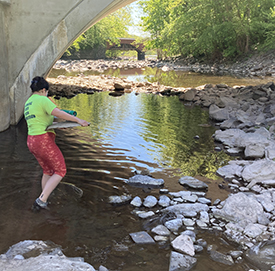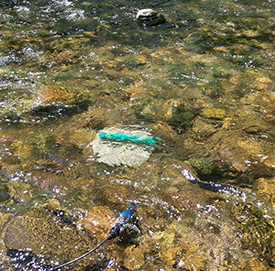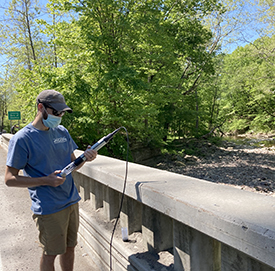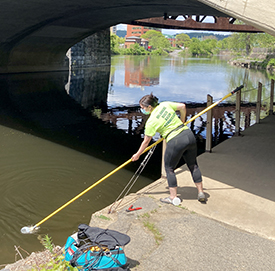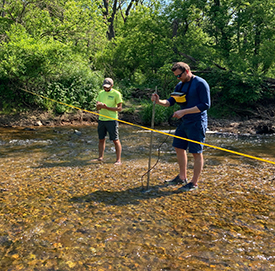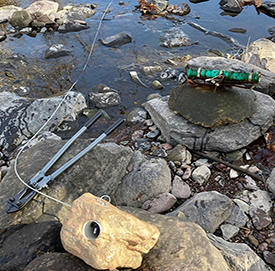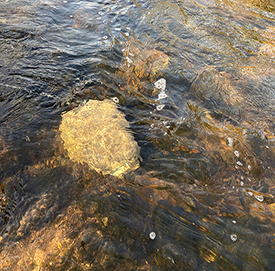Delaware • New Jersey • Pennsylvania
New York • United States of America
- Aquatic Life Designated Use Project
- Bacteria Monitoring
- Biomonitoring Program
- Chlorides Monitoring
- Contaminants of Emerging Concern
- Delaware Estuary Water Quality Monitoring Program
- Dissolved Oxygen and Nutrients
- Modeling
- Other Monitoring (e.g., Toxicity, Fish Tissue, Metals)
- PCBs and PMPs
- Special Protection Waters (SPW)
- Water Resource Data Sets
- New! Involved in Winter Road Maintenance? Take Our Anonymous Survey!
- A Water Quality Concern
- Chlorides in the Delaware River Estuary
- Increasing Chlorides in the Non-Tidal Delaware River
- Salinity Impacts Freshwater Toxicity (SIFT) Workgroup
- Additional Resources
DRBC Requests Input on Road Salt Application Practices (November 2025)
- Anonymous input from municipal staff, contractors, and decision-makers requested
- Complete the Survey (opens in new window; no deadline)
Why Care about Chlorides?
- The Delaware River is undammed for its entire length, allowing for the movement of salt from the ocean into the Delaware River Estuary.
- Delaware River Basin roadways are routinely treated with road salt and other de-icing agents during the winter, which enter our waterways.
- Salt is not easily removed from water during treatment. Chlorides found in surface water and wastewater at elevated concentrations can impart a salty taste to drinking water and potentially impact public health.
- Dissolved salts can accumulate in groundwater and slowly release into surface waters, compounding the problem over time.
- Salinity levels also affect aquatic life and other living resources.
DRBC Management of Chlorides
- In the Delaware River Estuary (tidal river)
- In DRBC Special Protection Waters (draining to the non-tidal river)
In the Delaware River Estuary, salt water mixes with freshwater.
Higher chloride concentrations indicate the degree to which ocean derived saltwater has moved into the freshwater portion of the upper estuary, near Philadelphia and Camden, where drinking water intakes are located.
In addition to impacting treatment costs for public water suppliers, salty water increases corrosion control costs for other surface water users, for example, industry.
Water Quality Criteria: Chlorides
- DRBC has adopted criteria for chlorides and sodium and monitors chlorides to ensure water quality remains suitable as a source of drinking water and protective of aquatic life.
- See the data! Visit https://drbc.net/Sky/waterq.htm (scroll down ~halfway) to view a current comparison of estimated chloride concentrations to criteria for water quality zones 2 and 3 (map of zones; pdf).
- Data show that criteria exceedances do occur in Zone 2 (Trenton, N.J. to Palmyra, N.J.) when winter storms are timed with periods of low flow.
- See the data! Visit https://drbc.net/Sky/waterq.htm (scroll down ~halfway) to view a current comparison of estimated chloride concentrations to criteria for water quality zones 2 and 3 (map of zones; pdf).
Monitoring the Salt Front
The DRBC's Hydrology/Flow Management Program focuses on freshwater releases to control the upstream migration of salty water from the Delaware Bay during low-flow conditions.
One important metric that is monitored is the seven-day average location of the salt front, the 250 mg/L chloride concentration based on drinking water quality standards. The salt front indicates water that is too salty to be used for drinking water.
The salt front's location fluctuates in the Delaware River Estuary with the tide and with increases or decreases of freshwater streamflow, which either dilute or concentrate chlorides in the river.
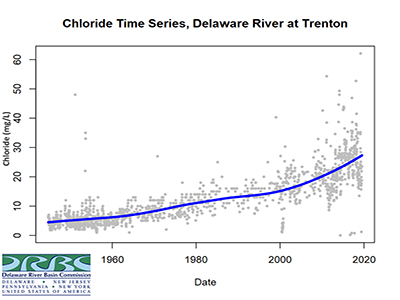 |
| This graph shows the increase in chlorides at the Delaware River at Trenton, N.J. Graphic by DRBC. |
In the non-tidal Delaware River, salinity levels are primarily influenced by natural factors such as geology, precipitation and evaporation. However, human activities such as agricultural runoff, de-icing salt applications, wastewater discharges and mining processes also contribute to increasing salinity levels, leading to freshwater salinization.
Monitoring Chlorides in Special Protection Waters
Elevated chloride concentrations are also a concern in the non-tidal Delaware River, which are protected under DRBC's Special Protection Waters(SPW) regulations.
Over the past several years, instream monitoring of the non-tidal river has shown an upward trend in chloride concentrations. While concentrations are still below criteria for drinking water and aquatic life use, the DRBC is watching this trend closely.
This trend is not just seen in the Delaware River's freshwater, it is becoming commonplace in areas of the U.S. with significant roadway de-icing activity. Studies suggest that chloride concentrations in winter are as much as a hundred-fold over summertime levels. Also, higher chloride concentrations increase as a function of impervious surface.
Additional monitoring and investigation into sources, mitigation measures and de-icing alternatives to salt and brine are needed.
Study: 2021-2023
From 2021 - 2023, the DRBC performed a two-year study to monitor chlorides, other ions and TDS concentrations in the non-tidal Delaware River watershed.
A mix of mainstem and tributary locations was chosen, for a total of 27 sites.
• View Map of Monitoring Locations
• Monitored Ions included: chlorides, TDS, nitrate, calcium, magnesium, sodium, potassium, sulfate, total silica, total alkalinity, total suspended solids and total phosphorus
At seven tributary sites, DRBC deployed continuous specific conductance and temperature loggers; the remaining sites already have continuous data being collected.
To complement the continuous data collection, staff sampled each site once monthly for conductivity and temperature. The loggers were maintained regularly throughout the study period.
Looking Ahead
In 2024, staff focused on analyzing the data collected from 2021 through 2023. The second phase of this project - as funding allows - could include targeting a subset of the 2021-2023 non-tidal chloride monitoring sites for further and more frequent monitoring during winter months. Monitoring would be done with continuous conductivity loggers and grab water samples for chloride, magnesium, potassium, sodium and other ions. This phase could also include outreach to highlight areas of concern, troubleshoot probable causes of degradation and educate the public about the issue.
Data to Date
Data show an increasing trend in chloride concentrations, but still below criteria for aquatic life and drinking water. A report is forthcoming.
- Highway Deicing Salts linked to Increased Sodium and Chloride Levels in the Delaware River at Trenton, N.J. (jpg)
- Chloride Concentrations at SPW Delaware River & Tributary Sites (jpg)
- Map showing DRBC Chloride Sampling at 25 Sites (2021-2023) (jpg)
SIFT Workgroup
In 2022, the DRBC formed the Salinity Impacts Freshwater Toxicity (SIFT) Workgroup to collaboratively sift through the escalating issue of freshwater salinization and increasing chlorides in rivers and streams and discuss regulatory and road salt management options. The workgroup is made up of DRBC partner agencies, ngos and a few consulting groups and meets quarterly.
DRBC Presentations/Information
- Chlorides in the Delaware River Basin: Charting a Pathway Forward (pdf; given at the October 2025 Upper Delaware River Rendezvous)
- Chloride Trends in the Delaware River's Special Protection Waters (pdf; given at the April 2025 NJ-AWRA Lightning Talk)
- Chloride Trends in the Non-Tidal Delaware River & Pathways Forward (pdf; given at the March 2025 Regulated Flow Advisory Committee Meeting)
- Chlorides Management and Monitoring (pdf; given at the April 2024 Water Quality Advisory Committee Meeting)
- Restoring Water Quality in the Main Stem Delaware River: Programs, Policies and Strategies (presentation given by DRBC staff at the 9th Annual Delaware River Watershed Forum, Sept. 2021; pdf 3.6 MB)
- Non-Tidal Chloride Monitoring 2021-2023 (presentation given at the Nov. 2020 joint MACC-STAC Meeting; pdf 6 MB)
- A Fishable, Swimmable (and Drinkable) Delaware River Estuary (presentation given at the Sept. 2020 Delaware River Watershed Forum; pdf 6.7 MB)
- Evaluation of SPW Chloride Data (presentation given at the July 28, 2020 WQAC Meeting; pdf 3 MB)
- History of the Salt Front (presentation given at the October 2019 CDRW Forum; pdf 2 MB)
- Chloride Trends (presentation at the March 29, 2018 WQAC Meeting; pdf 1.4 MB)
- Graphic showing chloride concentrations from 2014-2018 in Delaware Estuary Water Quality Zone 2 as compared to DRBC criteria (png 17 KB)
- Chloride and/or sodium concentrations in Delaware Estuary Water Quality Zones 2 and 3 as compared to DRBC criteria (link to DRBC water quality graphs using R scripts; scroll down for chloride graphs)
- DRBC Delaware Estuary Water Quality Zones (jpg 364 KB)
Additional Links of Interest
- Izaak Walton League of America: Salt Watch
- Little Lehigh Watershed Stewards: Salt Deep Dive and Salt Snapshot
- New Jersey Watershed Watch Network: NJ Salt Watch
- New York: Rock Salt Reduction
- Penn State Extension: Environmental Hazards of Road Salt
- Stroud Water Research Center: Cut the Salt Campaign
- Tookany/Tacony-Frankford Watershed Partnership: Road Salt Fact Sheet
- USGS: Chlorides, Salinity, and Dissolved Solids
- USGS Publication: Long-term impacts of impervious surface cover change and roadway deicing agent application on chloride concentrations in exurban and suburban watersheds (August 2022)
- Winter Salt Week
Copyright © Delaware River Basin Commission,
P.O. Box 7360, West Trenton, NJ 08628-0360
Phone (609)883-9500; Fax (609)883-9522
Thanks to NJ for hosting the DRBC website

